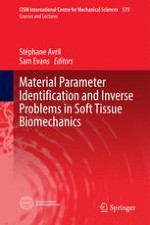2017 | OriginalPaper | Buchkapitel
2. Hyperelasticity of Soft Tissues and Related Inverse Problems
verfasst von : Stéphane Avril
Erschienen in: Material Parameter Identification and Inverse Problems in Soft Tissue Biomechanics
Aktivieren Sie unsere intelligente Suche, um passende Fachinhalte oder Patente zu finden.
Wählen Sie Textabschnitte aus um mit Künstlicher Intelligenz passenden Patente zu finden. powered by
Markieren Sie Textabschnitte, um KI-gestützt weitere passende Inhalte zu finden. powered by
